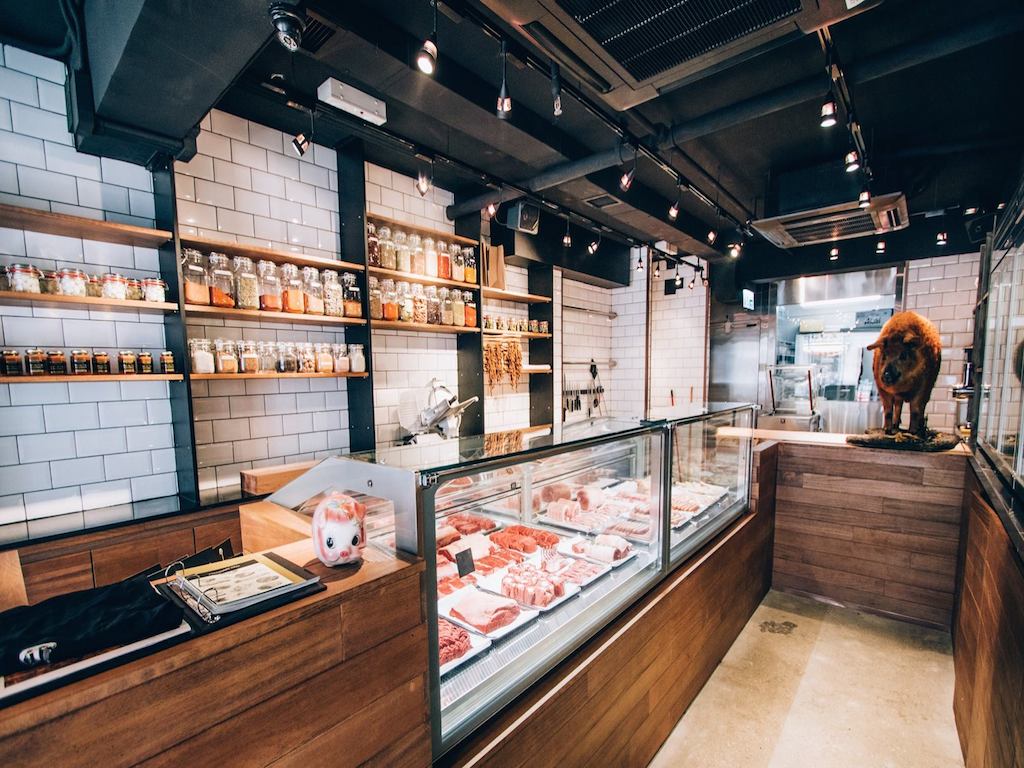5 Mins Read
Considering what we know about the squalid conditions of mass meat production and industrial factory farming of animals, it comes as no surprise that sourcing quality, sustainably-reared meats is incredibly important. But where do you go as a conscious carnivore if you don’t want to settle for unlabeled supermarket styrofoam? Are their any quality meat purveyors in Hong Kong? The answer is not many, though Bones & Blades is one such establishment. From the group that brought you Pastis, Metropolitain, and Alchemy comes French Creations’ newest baby, Bones & Blades, an old-fashioned butcher shop in Sai Ying Pun with some serious chops! On a bright and sunny Tuesday afternoon, the boys in blue (aprons), master butchers Seth McKenzie and Stephen Weblin, talk me through the mission of Bones & Blades and their ethical animal farming philosophy.
“The idea was to do a sustainable, ethical butcher shop,” says McKenzie of the eight-month old shop. “We source organic, and at the very least, grass-fed meat. Nothing is grain-fed, just because cows aren’t really intended to eat grain.” Serving up hormone- and antibiotic-free meats and poultry, Bones & Blades is all about sourcing from artisan, small-scale, family-owned farms. They bring in Australian pasture-fed Angus and Hereford beef and organic and grassfed OBE beef from Australia, as well as Wagyu from New Zealand. There is the rare-breed Mangalica pork (that’s the woolly hog you see in the shop window) from Hungary and an Australian pork as well. Their Hawke’s Bay lamb comes from New Zealand. The 81-day free-range chicken is from Hungary. When this inexperienced poultry writer wrinkled her nose over the “81 day” phrase, McKenzie segued into a quick Raising-Chickens-101 overview. “Most barn-raised birds are selectively bred so they grow quickly. When you give them antibiotics and hormones, it only takes about two to three weeks until they are ready for slaughter,” he explains. “Our free range birds are out running around and you’ll notice the quality change in the meat: the bones are a lot harder, the joints actually fit together more closely because they’re actually exercising and they take 81 days to grow.”
One of the perks of visiting a traditional butcher shop is the wealth of knowledge that abounds from the masters of meat, aka the butchers themselves. For most Hong Kong shoppers, this will be a rarity. McKenzie and Weblin are incredibly well-versed in all things animal protein and were happy to answer questions and offer tips on how to prepare any of their cuts. But the best feature that makes Bones & Blades a cut above (!) their competition is their “Nose to Tail” concept (aka using every part of the animal intelligently), where their social consciousness comes to life via an open air 20-seater restaurant right next door, Quarter Master. Let’s take their Mangalica hog, for starters. McKenzie and Weblin will take off all its lard (pork fat) to use in the French fries next door. Hence, piggy fries. (Some studies have shown cooking with high quality animal fat can be beneficial, witness the rise of pasture-raised ghee, tallow and lard in health food shops…)
“That was the other angle of opening a butcher shop and a restaurant,” says McKenzie. “Butcher shops traditionally have a bit of waste. It’s what we refer to as trim, all the end bits. But if you have a restaurant next door, then nothing really gets thrown away. You get in sustainable products that are healthy and you don’t throw anything away.” The offal will go into other recipes like a pork terrine (similar to pâté) or traditional British fare like faggots (essentially a big meatball). They’ll bring in a whole lamb that Weblin will usually cut up on Mondays, and whole chickens where the carcasses will go into chicken broth made for customers to purchase. Also popular on the menu are fresh, homemade sausages. There are usually three standard flavors (breakfast sausage, Cumberland sausage, and Italian sausage) and then three additional flavors that change each week based on what’s in season and what’s on offer at the wet market.
You are not just winning on sustainability, the taste profile of sustainably-raised meat is also far superior than factory-farmed varieties. Plenty of research has been conducted about how the welfare of animals leads to better meat quality. Animals that are frightened and live in cramped conditions before slaughter release a breakdown of muscle glycogen, essentially a hormone, that darkens the color of meat and turns it acidic and tasteless. It’s also believed that consuming meat and poultry with those elevated levels of stress hormones can affect our reproductive systems and other bodily functions. When animals are less stressed before slaughter, their meat has a lower pH level and the glycogen that remains in the muscle is converted into lactic acid, which helps to maintains its texture, flavor and color.
With my newfound understanding of the ecological significance between farm and meat connection, I follow my appetite and step next door to Quarter Master for a deliciously tasty set lunch menu of (grass-fed beef) burger and (rare-breed pork fat) French fries.
In addition to premium quality meats, Bones & Blades offers homemade sausage, ready-made bone broth, stews, dressed and ready-to-cook items like porchetta and stuffed lamb breast.
Bones & Blades, 1 Second Street, Sai Ying Pun; +852 2540 0067, info@bonesnblades.com. For more information, find them on Facebook or click here.
Images courtesy of Bones & Blades (lead) and Green Queen.








